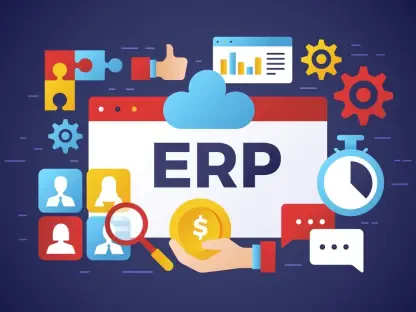Imagine a business at a critical juncture, where every lead, every deal, and every customer interaction could determine its growth trajectory—yet the sheer volume of data and tasks overwhelms the sales team. In such a scenario, choosing the right customer relationship management (CRM) platform becomes not just a strategic decision but a lifeline for efficiency and success. Salesforce and Zoho CRM stand as two prominent solutions in this space, each offering unique strengths to tackle these challenges. This comparison dives deep into their capabilities, highlighting how they address modern sales demands and cater to varying business needs. By dissecting their features, integrations, usability, and limitations, the aim is to provide clarity for organizations seeking the ideal tool to streamline operations and drive revenue.
Understanding Salesforce and Zoho CRM: Background and Relevance
Salesforce and Zoho CRM rank among the leading CRM platforms, designed to empower businesses in managing customer relationships with precision and insight. Salesforce, often regarded as the gold standard for enterprise solutions, offers a comprehensive suite of tools that transform how large organizations handle sales, marketing, and customer service. Zoho CRM, on the other hand, positions itself as a versatile and accessible option, particularly appealing to small and medium-sized businesses (SMBs) looking for robust functionality without the hefty price tag. Both platforms serve a common purpose: organizing leads, tracking sales opportunities, and fostering stronger customer connections through data-driven strategies.
The relevance of these tools in today’s business landscape cannot be overstated, as companies across industries face mounting pressure to optimize sales processes amid digital transformation. Salesforce often caters to complex, multi-layered organizations with its scalable, customizable architecture, making it a staple in sectors like finance and technology. Conversely, Zoho CRM shines for SMBs in retail, consulting, and startups, where budget constraints and simplicity are key considerations. Their widespread adoption reflects a broader trend of leveraging technology to enhance customer engagement and sales efficiency.
Setting the stage for a detailed comparison, it’s clear that the choice between these platforms hinges on specific business needs and sales strategies. While one offers depth and sophistication for intricate workflows, the other prioritizes affordability and ease of use for agile teams. Understanding their backgrounds and target audiences provides a foundation to explore how each CRM aligns with organizational goals, whether for expansive enterprises or nimble SMBs aiming for growth.
Feature-by-Feature Comparison: Key Differentiators
Automation and AI Capabilities
Automation stands as a cornerstone for both Salesforce and Zoho CRM, significantly reducing manual workloads for sales teams. Salesforce excels with its advanced workflow automation, enabling intricate processes like automated task assignments and follow-up triggers to run seamlessly. Its Einstein AI takes this further by offering predictive analytics, helping sales reps identify high-potential leads and anticipate customer needs with remarkable accuracy, thus sharpening decision-making.
Zoho CRM counters with its own robust automation tools, tailored for accessibility even among smaller teams. Features like automated email responses and pipeline updates free up time for relationship-building, while Zia AI provides lead prioritization and sales forecasting. For instance, Zia can analyze past data to suggest which prospects are most likely to convert, offering actionable insights without the complexity often associated with enterprise tools.
The distinction lies in scope and sophistication: Salesforce’s AI-driven automation suits businesses with vast data sets and nuanced sales cycles, such as a multinational corporation predicting market trends. Zoho CRM, however, offers a more straightforward approach, ideal for a local retailer aiming to automate follow-ups without needing extensive technical expertise. Both platforms enhance efficiency, but their application varies based on team size and analytical demands.
Integration and Ecosystem
Integration capabilities play a pivotal role in ensuring a CRM fits into a business’s existing tech stack, and both platforms deliver strong options. Salesforce boasts an expansive ecosystem through AppExchange, a marketplace with thousands of third-party applications ranging from marketing automation to advanced analytics. This vast network allows enterprises to tailor their CRM environment extensively, making it a powerhouse for organizations requiring seamless connectivity across multiple tools.
Zoho CRM holds its own with over 1,000 integrations, including a tight-knit connection to its native suite of business applications like Zoho Books and Zoho Desk. This creates a unified experience for users already within the Zoho ecosystem, reducing friction for SMBs that rely on a cohesive set of tools. Its integration strength lies in providing a streamlined setup for businesses without the need for external consultants or complex configurations.
Scalability and adaptability are heavily influenced by these ecosystems. Salesforce’s broader integration options cater to large firms with diverse software needs, ensuring flexibility as operations expand. Zoho CRM, while slightly less extensive, offers enough versatility for smaller entities to grow without overcomplicating their workflows. The choice often depends on whether a business prioritizes depth of customization or simplicity in connectivity.
User-Friendliness and Pricing Flexibility
Ease of use remains a critical factor for CRM adoption, as sales teams need tools that minimize onboarding time. Salesforce, with its depth of features, often presents a steeper learning curve due to a complex interface packed with customization options. While powerful, this can necessitate formal training or dedicated support, especially for teams unfamiliar with enterprise software, potentially slowing initial implementation.
In contrast, Zoho CRM emphasizes an intuitive design that simplifies navigation, making it easier for users to get started quickly. Its straightforward layout and accessible dashboards are particularly beneficial for SMBs where staff may wear multiple hats and lack time for extensive learning. This user-friendliness ensures faster adoption, allowing teams to focus on sales rather than software mastery.
Pricing models further differentiate the two, with Salesforce adopting a tiered, enterprise-focused structure that reflects its comprehensive capabilities, often starting at a higher cost. Zoho CRM, however, offers more affordable plans with flexible options, catering to budget-conscious businesses while still delivering essential features. The trade-off is clear: Salesforce provides unmatched functionality at a premium, whereas Zoho prioritizes cost-effectiveness, sometimes at the expense of advanced depth, requiring businesses to weigh immediate costs against long-term value.
Challenges and Limitations: Considerations for Adoption
Implementing a CRM comes with inherent challenges, and Salesforce’s primary hurdles include its high cost and complexity. For smaller businesses, the financial investment can be prohibitive, often requiring additional budget for customization and training. The platform’s sophisticated nature also demands technical expertise, which may necessitate hiring dedicated IT staff or external consultants to fully leverage its potential.
Zoho CRM, while more accessible, faces limitations in meeting highly complex, enterprise-level requirements. Its feature set, though broad for SMBs, may fall short for organizations with intricate sales processes or massive data volumes, where Salesforce’s robust infrastructure shines. Additionally, some users report occasional delays in support responsiveness, which can hinder resolution of critical issues during peak operational times.
Technical challenges also vary between the two platforms. Salesforce’s need for specialized support for customization can strain resources, especially for firms without in-house expertise. Zoho CRM, while easier to manage, sometimes lacks the depth of advanced features or scalability needed for rapid expansion, potentially requiring a switch to a more powerful system as business needs evolve. These considerations highlight the importance of aligning CRM choice with current capacity and future aspirations.
Final Verdict: Which CRM Fits Your Needs?
Summarizing the comparison, Salesforce and Zoho CRM each bring distinct strengths to the table across automation, AI capabilities, integration ecosystems, user-friendliness, pricing, and limitations. Salesforce stands out for its unparalleled depth in automation and AI through Einstein, vast integration options via AppExchange, and scalability for complex needs, though it comes with higher costs and a steeper learning curve. Zoho CRM counters with accessible AI via Zia, seamless integrations within its ecosystem, intuitive design, and budget-friendly plans, albeit with constraints in handling enterprise-scale demands.
Guidance for selection hinges on business size, financial resources, and sales objectives. Large enterprises with intricate workflows and the budget for customization will find Salesforce an ideal match, as its robust framework supports long-term scalability and sophisticated analytics. SMBs, particularly those prioritizing affordability and simplicity, will benefit more from Zoho CRM’s straightforward approach and cost-effective structure, which still delivers essential tools for growth.
Reflecting on the journey through this analysis, it becomes evident that aligning a CRM with operational priorities is crucial for sustained success. Businesses are encouraged to take actionable steps by assessing their immediate needs against long-term strategies, perhaps starting with a pilot program to test compatibility. Looking ahead, the focus shifts to monitoring how evolving technologies like AI will further shape these platforms, prompting organizations to stay adaptable. The decision made now is just the beginning, as continuous evaluation of CRM performance against sales goals promises to keep teams ahead in a dynamic market.









